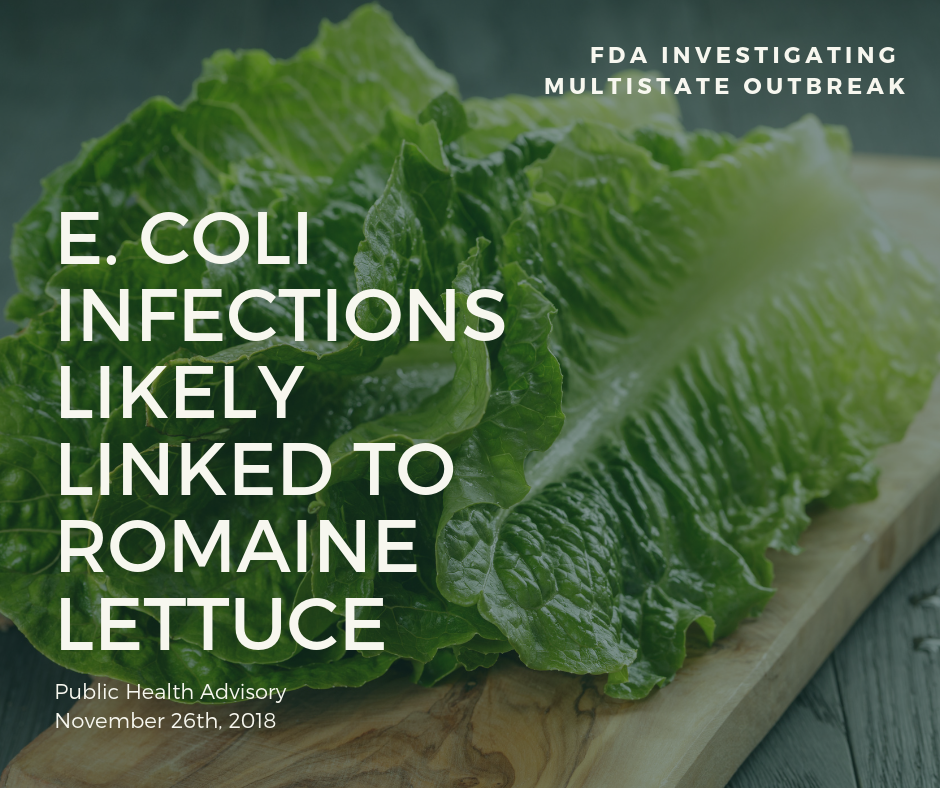FDA Investigating Multi-State Outbreak of E. Coli Infections Likely Linked to Romaine Lettuce

November 26, 2018 — The Food and Drug Administration (FDA), along with the Centers for Disease Control and Prevention (CDC) and state and local agencies, is investigating a multistate outbreak of E. coli O157:H7 illnesses likely linked to romaine lettuce. The Public Health Agency of Canada (PHAC) and Canadian Food Inspection Agency, are also coordinating with U.S. agencies as they investigate a similar outbreak in Canada. Genetic analysis of the E. coli O157:H7 strains tested to date from patients in this current outbreak are similar to strains of E. coli O157:H7 associated with a previous outbreak from the fall of 2017 that also affected consumers in both Canada and the United States. Information on the outbreak is located at: https://www.fda.gov/Food/RecallsOutbreaksEmergencies/Outbreaks/ucm593896.htm
The 2017 outbreak of E. coli O157:H7 was associated with leafy greens in the U.S. and romaine lettuce in Canada. This year, romaine lettuce is the suspected vehicle for both the U.S. and Canadian outbreaks. There is no genetic link between the current outbreak and the E.coli O157:H7 outbreak linked to romaine lettuce that occurred in the spring of 2018. Details are located at:
https://www.fda.gov/Food/RecallsOutbreaksEmergencies/Outbreaks/ucm604254.htm
The FDA is conducting a traceback investigation to determine the source of the romaine lettuce eaten by people who became sick. Additionally, FDA and states are conducting laboratory analysis of romaine lettuce samples potentially linked to the current outbreak.
As of November 20, 2018, thirty-two people infected with the outbreak strain of E. coli O157:H7 have been reported from 11 states. Nine of the reported cases so far have occurred in Los Angeles County. For this outbreak investigation, the average interval between when a person becomes ill and when the illness is reported to CDC is 20 days. CDC issued a Food Safety Alert advising U.S. consumers not to eat romaine lettuce.
Guidance to Healthcare Providers
Antibiotics are not recommended for patients with suspected Shiga toxin-producing Escherichia coli (STEC) infections until complete diagnostic testing can be performed and STEC infection is ruled out. Some studies have shown that administering antibiotics to patients with STEC infections might increase their risk of developing hemolytic uremic syndrome (HUS), and a benefit of treatment has not been clearly demonstrated. Features of HUS include low platelet count, anemia due to broken blood cells, and kidney failure.
Many non-O157 STEC infections are not diagnosed, even among more virulent STEC strains. Patients with more severe illness are generally more likely to seek medical care and to have stool specimens tested to determine the cause of illness. Non-O157 STEC are a diverse group of bacteria that vary in virulence. There are two general types of Shiga toxins, Shiga toxin 1 and Shiga toxin 2, and strains may produce one or both types at the same time. Strains that produce Shiga toxin 2 tend to be more virulent.
Confirmed and suspect cases should be immediately reported to Disease Control at 951-358-5107 during business hours; after hours at 951-782-2974.
Guidelines to ensure as complete as possible detection and characterization of STEC infections include the following:
All stools submitted for testing from patients with acute community-acquired diarrhea should be cultured for STEC O157. These stools should be simultaneously assayed for non-O157 STEC with a test that detects Shiga toxins or the genes encoding these toxins.
Clinical laboratories should report and send E. coli O157 isolates and Shiga toxin-positive samples to the Riverside County Public Health Laboratory (PHL) as soon as possible for additional characterization.
Specimens or enrichment broths in which Shiga toxin or STEC are detected, but from which O157 STEC are not recovered should be forwarded as soon as possible to Riverside County PHL so that non-O157 STEC can be isolated.
Often by the time a patient presents with HUS, the causative STEC can no longer be easily isolated from a stool specimen. For any patient with HUS without a culture-confirmed STEC infection, stool can be sent to the PHL for forwarding to the California Department of Public Health for additional testing. In addition, with prior approval, serum can be sent through a public health laboratory to CDC for serological testing for antibodies to some STEC serogroups.
Related Links for Clinicians
Clinical Practice Guidelines for the Diagnosis and Management of Infectious Diarrhea (Infectious Diseases Society of America, 2017)
https://academic.oup.com/cid/article/65/12/e45/4557073
MMWR – “Recommendations for Diagnosis of Shiga Toxin–Producing Escherichia coli Infections by Clinical Laboratories”[PDF – 20 pages]
https://www.cdc.gov/mmwr/PDF/rr/rr5812.pdf
Recent E. coli Outbreaks https://www.cdc.gov/ecoli/outbreaks.html
